Like many comic book artists, Jack Kirby was fascinated by supernatural power. Of course much of this preoccupation would derive from the comic reading market that demanded heroes with super powers. Kirby was fascinated by science fact as well as science fiction, and would scour both in search of ideas. Early in his career, Kirby, with Joe Simon would develop characters that possessed extraordinary attributes, such as Blue Bolt and the Vision. Blue Bolt possessed powers that were related to ideas on the forefront of the science of atomic energy in the late 1930’s, while the Vision’s powers were pure magic.
Left to his own devices, Kirby would often tend to focus more on heroes who were naturally strong and acrobatic. Even Captain America, who received Professor Reinstein’s super serum, was essentially just an exceptional athlete. In 1954, Simon & Kirby’s Crestwood publications introduced Fighting American. The character had a fairly unique origin, in that his soul had been transferred from his own body into that of his revitalized brother. Although not unusual for a comic book character, the idea of the transference of a life force still conjured notions of a supernatural world somewhat resembling existing esoteric religious beliefs.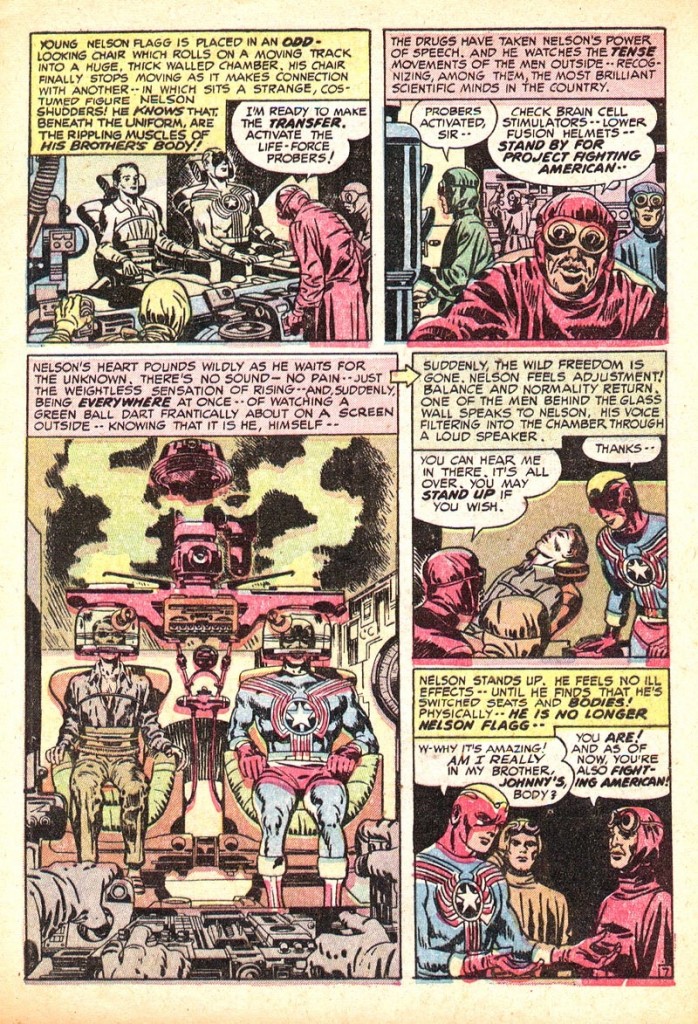
When called upon to depict such an occurrence, few artists could surpass Kirby in his ability to make such wonders believable and vividly hyper-real. The machine that Kirby constructed is also strikingly believable. The master was always capable of designing a contraption that looked like it did the job in question. The text was also evocative, describing Nelson Flagg’s life force as a ball darting about the screen that he is watching, as he reincarnates.
Throughout his lifetime, Kirby created several characters whose souls would switch bodies, or whose bodies would simply transform. This transformation was usually accompanied by a wonderful visual display of cosmic forces at work. When he began his historic stint at Marvel, The Fantastic Four’s character, The Thing was an immediate hit, with his propensity to change unpredictably from human to creature and back again. This page from Fantastic Four #40 is arguably one of Kirby’s most powerful and moving examples of this metamorphosis. What is most striking here is the situation in which Reed Richards feels compelled to transform Ben Grimm seemingly against his will. One can see the resentment and weary resignation in the Thing’s expression as he rises from the floor.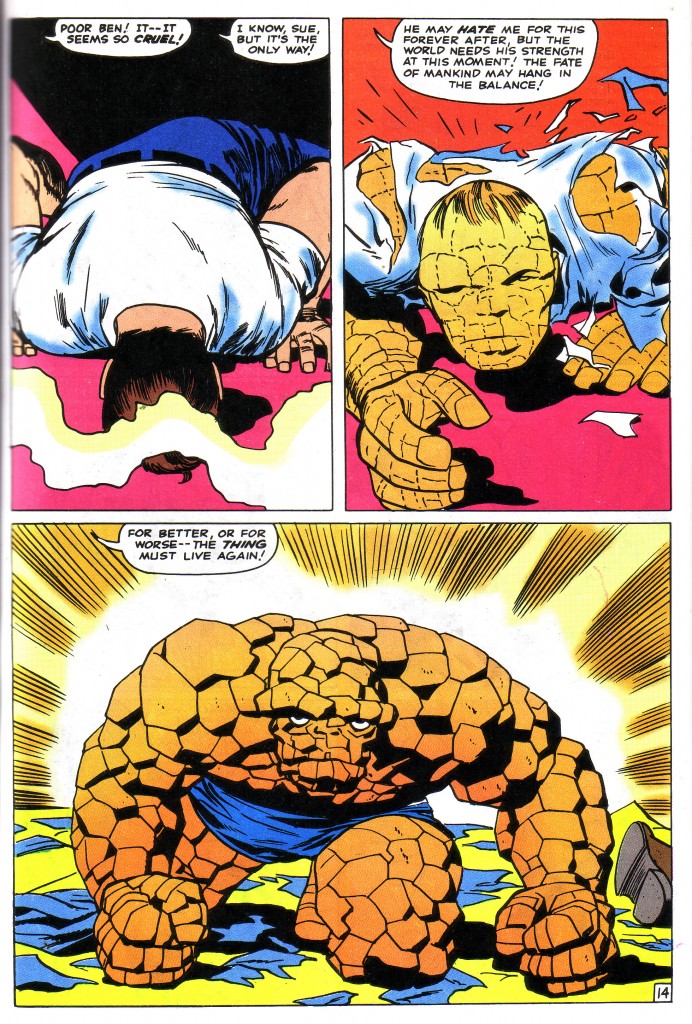 This is a wonderful three panel sequence that elucidates human nature is a way that only a genius like Kirby can. After Reed’s ray strikes him, Ben falls to the floor. As he begins to rise in panel two, he no longer appears to be a sentient being, but a sort of mindless primordial reptilian entity from the dawn of time. His right hand is moving forward mechanically and gesturing just above the level of the Thing’s head in panel three, focusing the reader’s eye on that grim visage.
This is a wonderful three panel sequence that elucidates human nature is a way that only a genius like Kirby can. After Reed’s ray strikes him, Ben falls to the floor. As he begins to rise in panel two, he no longer appears to be a sentient being, but a sort of mindless primordial reptilian entity from the dawn of time. His right hand is moving forward mechanically and gesturing just above the level of the Thing’s head in panel three, focusing the reader’s eye on that grim visage.
The most cosmic transformation should be that from man to god, or in reverse. Kirby explored such concepts numerous times over the years, beginning in the 1940’s, and continuing into the 80’s. Thor’s Hammer was a particular fixation for the artist. He used it twice at National and then at Marvel most famously. When Kirby did Thor in the sixties, he and Lee explored the idea of the object of the hammer transforming both itself and its owner. This sequence in Thor #154 is one of the nicest examples of this transition.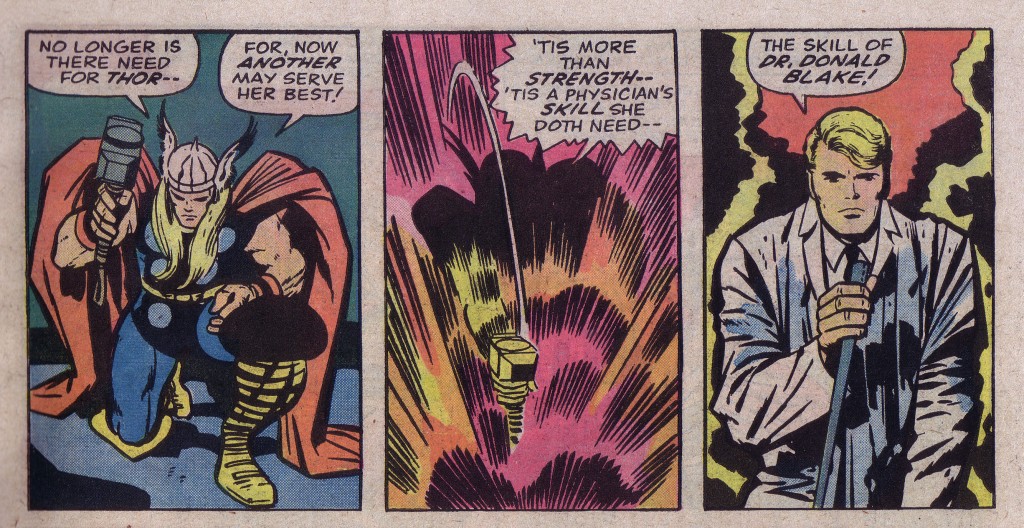
The three-panel sequence generally seems to be Kirby’s choice to most effectively depict transformation. While not the most dynamic series of figures, there is a nice subtle forward movement here beginning with Thor kneeling. As he strikes down with his hammer, the resulting explosion in panel two pushes Blake’s right hand holding the cane towards us in panel three to emphasize the change.
Thor’s series featured one of the most inventive of transformative beings, which I discussed in an earlier blog on cosmic energy. Ego the Living Planet was able to re-incorporate as a bi-pedal hominid or any number of other manifestations. Here is a fantastic drawing of him from Thor #155.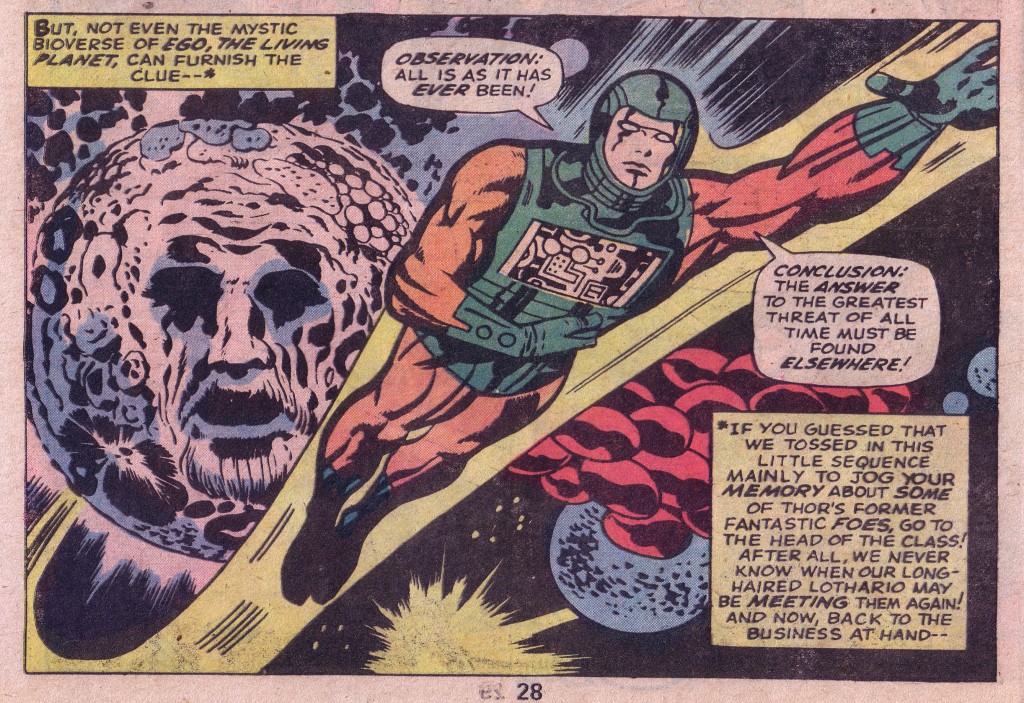
This particular panel dynamically depicts the character known as the Recorder in a signature Kirby pose with left hand extended, zooming up and outwards from the living planet. The planet and figure are surrounded by a fantastic interstellar environment of organic and intergalactic matter which give substance to and tie together the various compositional elements.
When Kirby left Marvel for National yet again, part of his new body of work was another exploration of Godhood. This time the gods emerged full-blown, without need of transformation. There were in fact several races of them, co-existing beyond the earthly sphere. Shown here, Orion and Lightray represented the Cosmic Clear light of the Source. Here, encircled by bands of energy, which guide him, Orion returns to his home planet.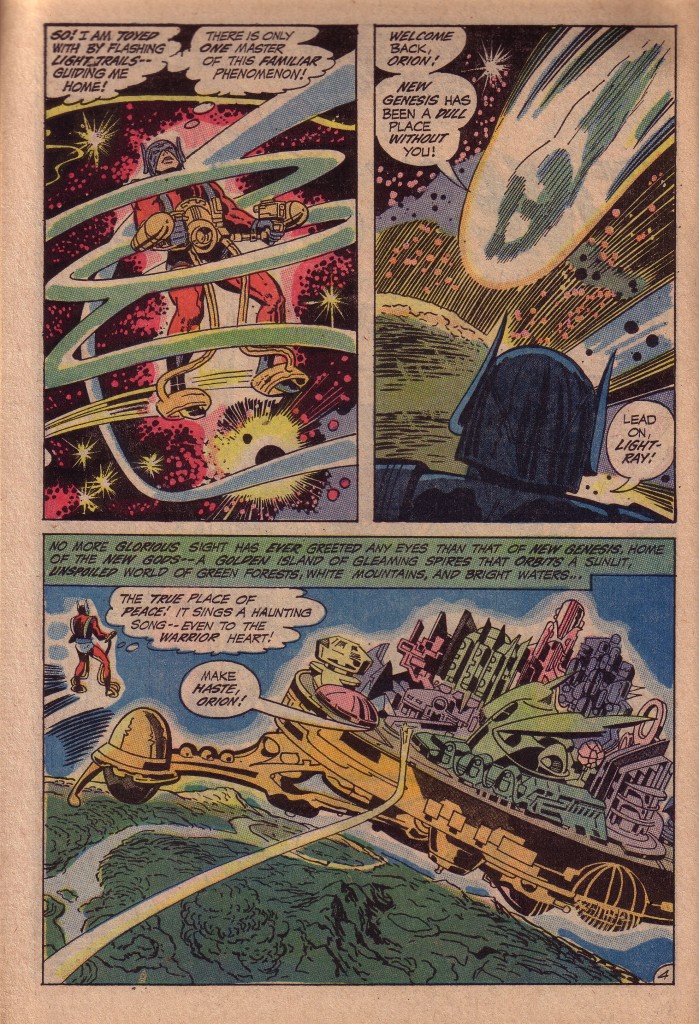
Having explored various magnificent depictions of a world fit for gods in Thor with his designs for Asgard, Kirby gives us a new twist here. It is a city that floats above a more pristine world below.
The energetic opposite of New Genesis is the dread planet known as Apokolips, which represents the dark aspect of the Source. In the first issue of New Gods, we discover that Orion is somehow connected to Apokolips and its ominous ruler, Darkseid. Contacted by the Source, the sentient energy that binds the universe together, Orion returns to the fire-pitted gulag planet Apokolips on a mission of discovery. Here we see a dark and ominous series of images, as the planet’s baleful inhabitants transform its very life force into the energy to sustain them. 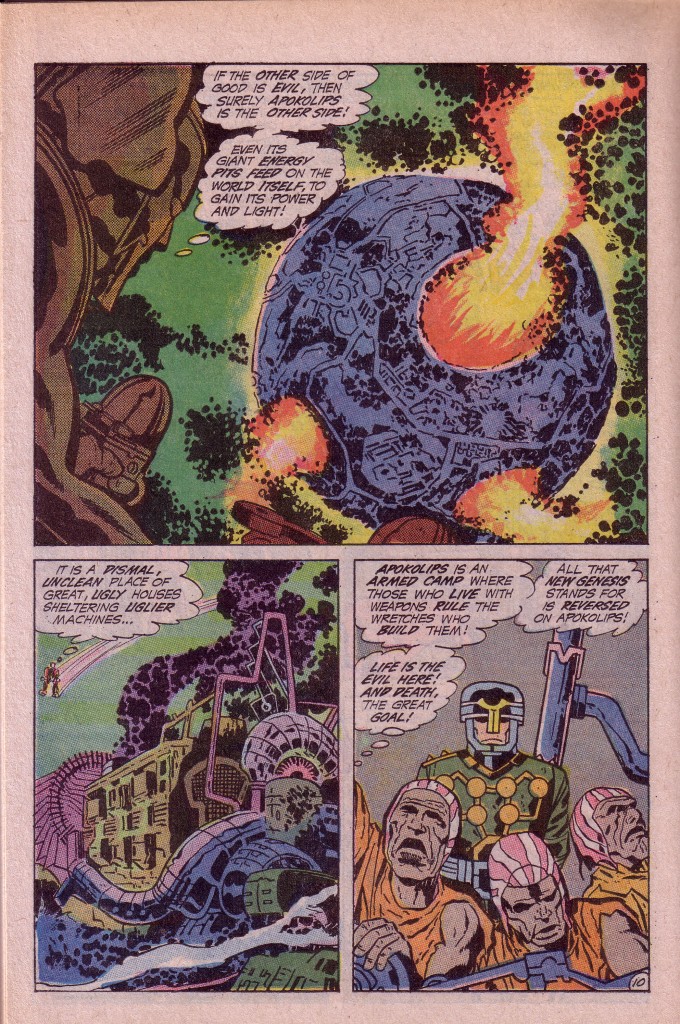
This is a powerful series of three panels yet again, which begins with a long shot of the planet from Orion’s point of view, and then moves in closer as we see the grim structures that make up the surface of Apokolips. Finally we zoom in on a close-up of the pathetic wretches toiling hopelessly.
This story in New Gods #1 is surely the base of the pinnacle that became Kirby’s magnum opus. Strange that Kirby’s Fourth World is often dismissed as being poorly written and conceived in comparison to his work with Marvel, when this series is arguably one of the most influential when it comes to its impact on popular culture. In Kirby’ depiction of the metamorphosis of the world of the old gods into the new, he has sown seeds that continue to bear fruit, far beyond the plagiarism that it has engendered and spawning reinterpretations into the evolving intricacies of the DC Universe.
Image 1- Fighting American #1, Joe Simon & Jack Kirby
Image 2- Fantastic Four #40, Jack Kirby, Stan Lee
Image 3- Thor #154 Jack Kirby, Stan Lee, Vince Colletta
Image 4-Thor #155 Jack Kirby, Stan Lee, Vince Colletta
Image 5-6 New Gods #1 Jack Kirby, Vince Colletta

